The fly that sips treacle is lost in the sweets – John Gay
From an early age I had a sweet tooth and I revelled in my weekly trip to the local shop where my pocket money could be spent. For the twenty pence piece I clutched in my small sweaty hand a colourful selection of candied treats could be mine. From white chocolate mice and squidgy fried eggs, to rhubarb and custard and pear drops. I can remember well the excitement of those sugary delights.
Unfortunately, as we grew older we realised that sugar has a darker side. Sugar is pure sensation, the ultimate comfort food. It has little nutritional value adding "empty calories" to our diets and rotting our teeth. The European hunger for sugar was an incredibly destructive force in the history of Africa and the Americas bringing slavery and environmental destruction. Even the word sugar in the English language is often used negatively, sometimes to indicate something deceitful: "sugar pills", "sugar-coated sentiments", or "sugar daddy". It is also used in processed food to mask excess salt and has been linked to obesity and other serious medical problems. Despite all this humans are in love with sugar, be it from our mothers milk, a sugary snack, or just a spoonful to help the medicine go down.
The first significant source of what we now understand as sugar was from the sugarcane plant which is thought to have originated in New Guinea about 2,500 years ago. Sugarcane is a gigantic grass sometimes reaching up to five metres high and, like the bamboo it resembles, flourishes best in a warm climate with fairly high rainfall. From New Guinea sugarcane spread to other islands of south-east Asia and later to India and China. Our language bears the traces of sugar's passage from India through the Middle East to Europe. The English word sugar comes from the Arabic imitation of the Sanskrit sharkara, meaning gravel, which early sugar resembled.
By 1518 the Spaniards were operating a number of sugar plantations on Hispaniola (present day Dominican Republic and Haiti) and in that year began the transatlantic slave trade. Slaves were required to tender this historically labour intensive crop. In Europe sugar remained a luxury until the 17th century. Despite the avalanche of sugar that was reaching Europe at the beginning of the 19th century Napoleon ordered that thousands of hectares of French land be planted with sugar beets. This was done to avoid dependence on English controlled sugar imports from the New World. Sugar beet is a root crop in the same family as beetroot and mangelwurzel; it is generally grown in developed (temperate) countries whereas sugarcane is produced principally in developing (tropical) countries.
The simplest method of consuming cane sugar is by chewing the cane itself. Once the tough outer bark has been stripped away the softer woody inside can be chewed and sucked to extract the sweetness. To convert this sweet liquid into crystalline sugar the canes are cut, shredded and crushed between rollers to extract the opaque dark-green juice. The juice is the colour of swamp mud and tastes of liquid brown sugar, heavy with caramel and molasses and with a harsh green, sap like after-taste. This juice is then heated and lime added. The heat and lime coagulate and remove proteins and other impurities from the juice. The resulting clear juice is then concentrated by evaporation and boiling until what is known as a massecuite – a mixture of sugar crystals and syrup (molasses) – emerges.
The separation of this mixture was traditionally performed in upright conical pots and the molasses allowed to drain over several days (if not weeks) though a hole in the base of the pot. This left a yellowish sugar loaf which was often still moist from residual molasses. In modern mills, centrifuges are used giving sugar crystals that are usually about 96% pure sucrose (the remaining 4% being water, invert sugar, dirt and sometimes sugar lice). Further refining of the sugar occurs in various stages ending in a final crystallisation process which is carefully controlled to give individual crystals of uniform size. These processes leave a table sugar that is an astonishingly pure; more than 99% sucrose sugar.
Scientifically, the word sugar refers to a number of carbohydrates of varying sweetness which are made from just three kinds of atoms: carbon, hydrogen and oxygen. The simplest (single) sugar molecules are refered to as monosaccharides, these include glucose and fructose. The chemical that we call table sugar is sucrose, this is a double sugar or disaccaride molecule consisting of one molecule of glucose and one of fructose joined together. The sucrose in sugarcane is the stored form of the energy obtained by photosynthesis; many plants store this energy as starch. Before they can be absorbed and used by the body disaccharides (and polysaccarides such as starch) must be broken down into glucose. This glucose is then "burned" (or oxidised) in tissues to produce energy releasing carbon dioxide and water. Glucose and fructose are also found independently in nature. Glucose is found in some fruits and vegetables, usually with other sugars. Fructose, as the name implies, is found mainly in fruits and is the sweetest of the common sugars.
Many of us indulge to excess in those things that give us pleasure. In the case of sugar this has led to people preaching a prohibition on sugar and so a feeling of guilt for liking and eating sweets. For me eating confectionery should and will always be a pleasure and making your own sweets an even greater pleasure. One of the simplest and most fun confectioneries to make at home is cinder toffee, also known as honeycomb or sponge toffee.
Ingredients
100g Fair trade caster sugar
3 tablespoons of golden syrup
1 teaspoon of bicarbonate of soda
Step 1 Mix the caster sugar and golden syrup together in a heavy bottomed pan large enough to accommodate the rising sugar when it bubbles up.
The hard dry nature of caster sugar seemingly stands apart from the shiny viscous texture of golden syrup but they are both just forms of sugar. Caster sugar is crystallised sucrose and golden syrup is a thick, amber-coloured form of "inverted" sugar syrup that was invented in 1883 by Scottish businessman Abram Lyle. An inverted sugar is a thick and treacly mixture of separated fructose and glucose and is formed when a solution of sucrose is heated; particularly in the presence of an acid. Certain enzymes will do the same thing, for example invertase in the small intestine. Inverted sugars occur naturally in honey and are produced in jams during the boiling of fruit with sugar (due to the high acidity). Golden syrup is a mixture of sucrose, invert sugar, water and salts.
Step 2 Put the pan on a low heat stirring with a wooden spoon until all the sugar crystals have dissolved, at this point stop stirring and heat until 145-150C.
The water in the golden syrup plays two important roles: firstly, it reduces the chance of burning since most of the initial heat goes into the work of evaporation of water molecules. Secondly, the amount of water in the sugar syrup is important for the texture of the confectionery. Generally, the less water the sugar syrup contains the harder the resulting confectionery will be. For making cinder toffee we want a very low concentration of water (1-2%). Luckily for us there is an easy way to achieve this very precise concentration.
The boiling point of a sugar syrup is greater than that of pure water and increases with increasing concentration of sugar in the syrup in a predictable manner. Thus, once the syrup is boiling the temperature can be measured and the cooking stopped at the appropriate temperature. At 113C (85% sugar) make fudge, at 132C (90% sugar) make chewy toffee and at 149C and above (nearly 100% sugar) make hard sweets. If the temperature goes too high we start to caramelise the sugar; breaking the sugar molecules apart generating both appealing colours and an increasing complexity of aromas and flavours. Heat too much and these aromas become bitter and the syrup burns.
For making cinder toffee I like to be at around 150C as I like a brittle toffee with only a little bit of chew to it. However, if you want a more sticky toffee then heat to a lower temperature. What if you don't have a thermometer? There are various methods you can try. One of the simplest is by taking a small amount of the syrup and dropping it into a glass of cold water. Take the solidified drop out and observe its texture; the harder the texture the higher the temperature. For making cinder toffee you need the sugar to form a hard ball that cracks on contact with the cold water (referred to as the hard crack temperature).
Step 3 Add the bicarbonate of soda, take off the heat, and stir.
This is by far the most exciting stage, when your hot sugar syrup will bubble up like a volcano giving your honeycomb texture. But be careful, the mixture will be very hot and sticky. Sodium bicarbonate (NaHCO3) is generally used in cake making to encourage the cake to rise by formation of carbon dioxide. In cakes, and model volcanoes, this decomposition to carbon dioxide occurs due to the presence of an acid. In this recipe it is mainly the heat of the sugar that causes the bicarbonate of soda to break down releasing carbon dioxide making your runny syrup bubble furiously. It is really important to make sure the sodium bicarbonate is well mixed or else your honeycomb may taste a bit salty (from excess sodium).
Step 4 Quickly pour the gooey bubbling mixture onto a baking tray covered with grease proof paper or greased foil.
The cooling stage in confectionery making is very important and determines whether the confectionery will be crystalline or non-crystalline. Crystalline confectionery is formed when molecules of dissolved sucrose collide and join together. If enough molecules join together they form orderly arrays and so dense solid masses or crystals. The size of these crystals changes the texture of the confectionery. If the sugar forms a few large crystals then the sweet texture will be coarse and grainy. If it forms many millions of microscopic crystals that are lubricated by just the right amount of syrup the candy will be smooth and creamy.
In non-crystalline confectionery the syrup is cooled fast enough so that the sugar molecules do not have time to arrange themselves into crystals and so form a liquid-like, or glassy, structure. This gives a hard and brittle texture like that of boiled sweets. This is what we want for cinder toffee and for this reason we cool the mixture quickly by pouring it on to a baking tray. We should also avoid using metal spoons; stirring once all the sugar has dissolved; and the presence of undissolved sugar crystals as all of these can induce crystallisation.
To help prevent crystallisation we also use an interfering agent, inverted sugar. The fructose and glucose in inverted sugars interfere with sucrose crystallisation. Here our source of inverted sugar is golden syrup. Glucose syrup can also be used as it has a similar effect but does not give the same flavour as golden syrup and the resulting toffee is generally less sticky. Honey is also an inverted sugar which gives a lovely flavour but I have found that it tends to burn very easily. If too much inverted sugar is added it increases the tendency for the cinder toffee to become sticky. There are many experiments possible to find the ultimate combination of these ingredients – I will leave them to your imagination.
Step 5 Leave to cool then transfer to an air-tight container (or your mouth). Or you can cover it in chocolate and then eat it.
If you are like my childhood-self who could never leave a bag of sweets unfinished it is unlikely that you will want to store the beautiful golden cinder toffee for any period of time. If you have the willpower then storage is best done under dry conditions as sugars have a strong affinity for water and tend to absorb it on to the surface of the toffee, making the surface sticky. This affinity for water can be useful as any bacterium that alights on the toffee will have its water sucked out into the toffee so it cannot grown. This affinity is also useful as the high water-solubility of sugar makes cleaning the pan no way near as difficult as it first appears!
Sugar confectionery is a simple joy, a fun tasty snack reminiscent of childhood. So, when you place a piece of cinder toffee in your mouth and feel the crunch of light brittle sugar and the slight stickiness on your teeth listen to your taste buds. Feel them get excited about the presence of sugar in your mouth. Feel the surge of energy as the glucose enters your bloodstream and then go and brush your teeth.
Andy Connelly is a cookery writer and former researcher in glass science at the University of Sheffield. He is training to become a science teacher
■ This article was amended on 24 September 2010. The original said that bicarbonate of soda was Na2O3. This has been corrected. Thanks to thatdog and others.
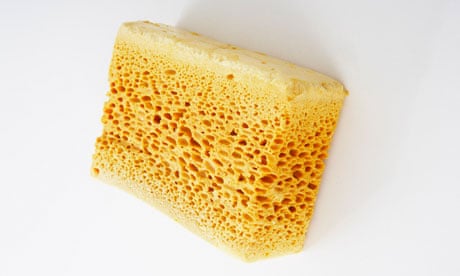

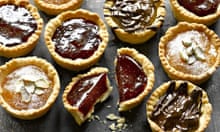


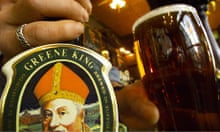
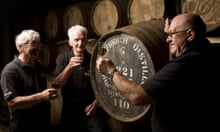
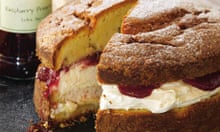
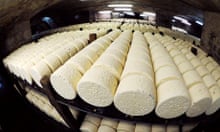
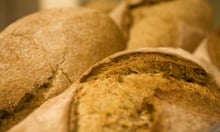
Comments (…)
Sign in or create your Guardian account to join the discussion